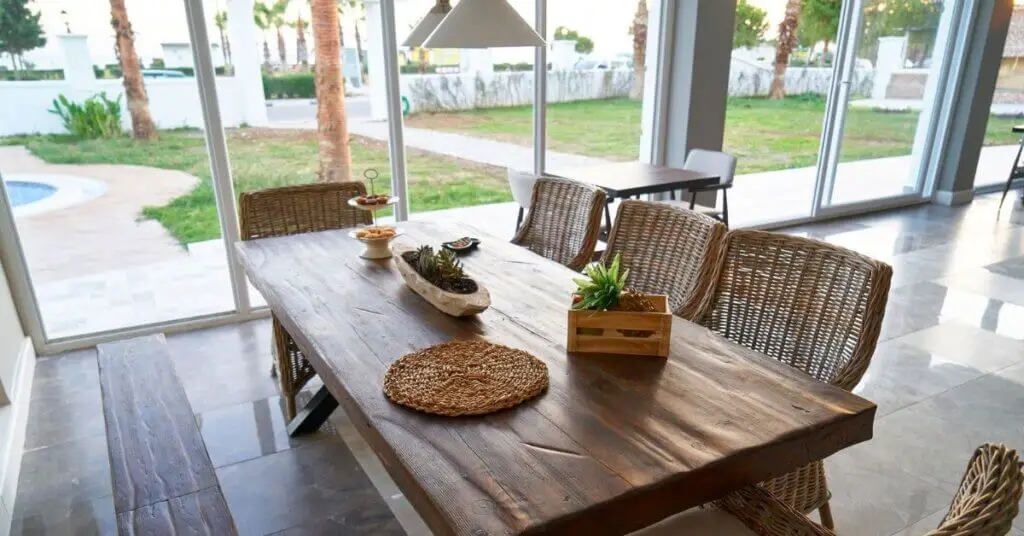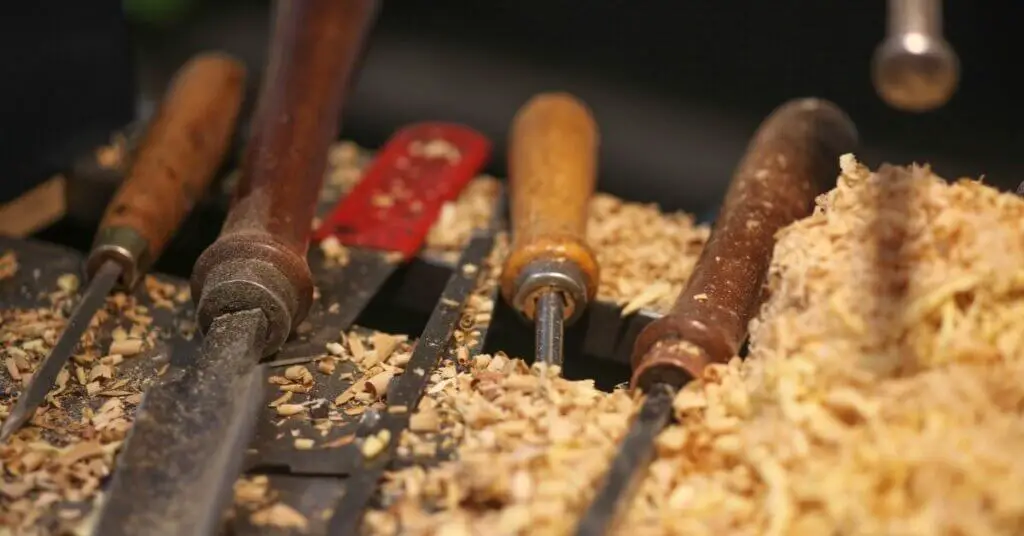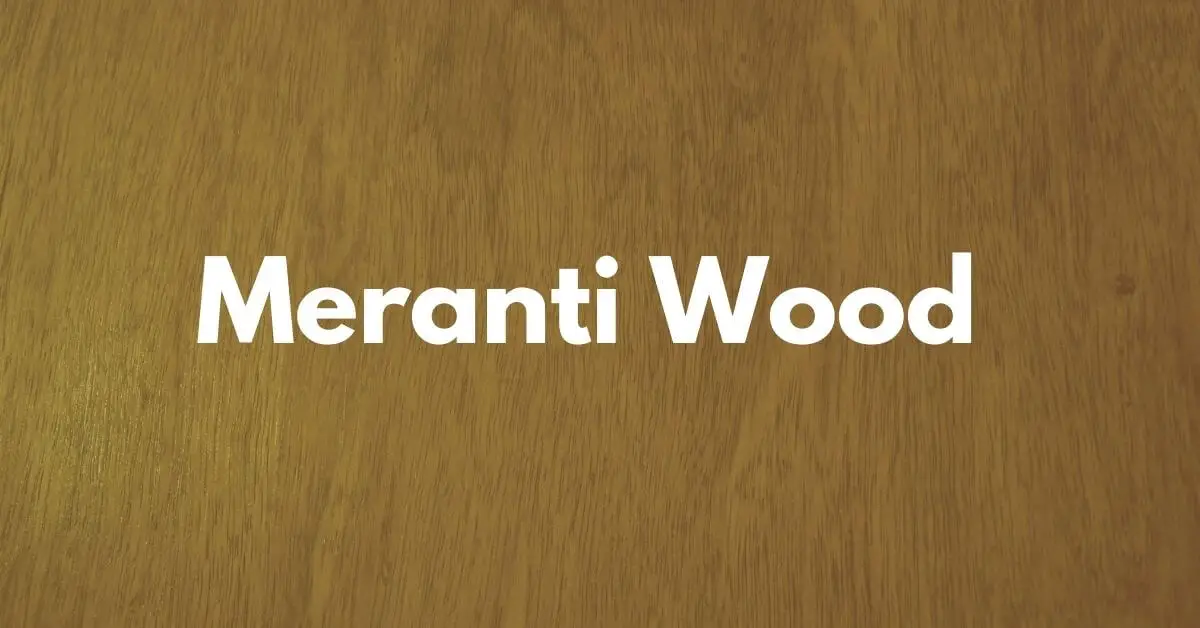Meranti Wood
Meranti is strong and stable hardwood. It is used for the construction industry, furniture, and boat building. Meranti wood is not very durable and not rot resistant. It is native to Southeast Asia.
Meranti wood is easy to work with and Glues, stains, and finishes well. Meranti wood is considered better for exterior/interior uses. But it does not perform well in extreme weather.
There are many types of meranti, Such as Light Red Meranti, Dark Red Meranti, White Meranti, Yellow Meranti, and Balau.
Most species of Shorea are rainforest trees, Merati trees can reach a height of about 65 to 130 feet (20-40 m). Most species of Shorea spp. are general flowering trees.
| # | Meranti |
| Scientific Name: | Shorea spp. |
| Tree Height: | 65-130 ft (20-40 m) tall, 3-6 ft (1-2 m) trunk diameter |
| Rot resistant: | Low or no rot-resistant |
| Workability: | Usually easy to work |
| Wood types: | Hardwood |
| Wood color | Pale pink to brown and reddish-brown |
| Uses: | Plywood, interior furniture, general construction, veneer, and boatbuilding. |
Meranti Wood Uses

Meranti wood is widely used to make plywoods, Meranti plywood is more durable and stronger than Meranti solid wood. Because it is passed through several treatment processes it improves its stability.
Meranti wood is a beautiful wood, used for making quality furniture. Meranti furniture is strong, durable, and attractive.
It has a natural brown color which becomes more attractive after staining and finishing.
Dark Meranti wood, also known as Lauan, Philippine Mahogany, is used for boatbuilding. Because it has better durability and water-resistant properties than other meranti species.
Meranti wood is not as popular as oak but meranti wood can be a good choice for general construction, walls, ceilings, and floors.
Meranti wood color
Merati heartwood(The inner dark-colored portion of a tree trunk) is dark reddish to pale pink with white resin streaks present. The sapwood (the outer light-colored portion of a tree trunk) is sometimes lighter than the heartwood. Sometimes sapwood is very similar to heartwood, So it is difficult to distinguish.
Generally, meranti has a straight grain but can also be interlocked. With a coarse texture and low natural luster.
Working with Meranti wood

Generally, Easy to work with hand and machine tools. Some species (Dark Meranti wood and Yellow Meranti) have interlocked grain, which can present problems during planing.
White Meranti contains a lot of silica(Silica is composed of silicon (Si) and oxygen (O2)), So it is responsible for the blunting effect on tools. There is also the problem of the fuzzy or ragged surface.
Staining
Meranti wood can be easily stained in the desired color(light or dark), it gives excellent results after stain. One of the best things about Meranti is that it accepts all types of stains.
After proper staining, it can be compared with real mahogany even though it’s not a close relative.
For smooth finishing and an attractive surface, you should fill its open grain. Therefore, you can use Pre-Stain Wood Conditioner.
Painting
Meranti holds paint and polish well, too, but to get a smooth and fine surface first use a good quality primer coat over its open grain.
You should apply two coats of wood primer before painting, keeping an appropriate time (20 to 24 hours) gap between both coats.
Primer creates a strong bonding between the wood and the paint. Which protects the wood from moisture and dust.
Meranti Wood Advantages and Disadvantages
Advantages
1. Natural color and appearance
Meranti has a dark reddish or purplish brown color that looks very attractive. After Finishing it gives a smooth and uniform look.
2. Availability and price
Meranti is widely harvested and available worldwide. It is available at an affordable price compared to many other hardwoods.
Meranti trees grow rapidly and their tree height is high. That’s why meranti forests produce more lumber.
3. Moderately durable
Generally, Meranti is moderately durable and stable hardwood. It can be used for indoor and outdoor projects but it is not suitable for extreme weather.
4. Resistant To Warping
Meranti hardwood is Resistant to warping or twisting, which means it is stable hardwood that is suitable for outdoor uses.
warping and twisting occur when the moisture content in the wood changes unevenly
4. Easy to work
As we know working with hardwood is not always easy but meranti has good workability properties. Due to the good density of Meranti, The holding capacity of the screw and nail is good.
Disadvantages
1. Not Rot-Resistance
Meranti is not insect resistant, they are susceptible to insect attack. It starts rotting due to exposure to moisture, soil, and extreme weather.
2. Not durable and strong
Meranti is hardwood but it is not very durable or strong, it is not suitable for heavy construction at all.
3. Regular Maintenance
If we compare other hardwoods, meranti wood requires regular care and maintenance. Treated meranti wood can be durable as compared to ordinary meranti lumber. But the cost of treated meranti lumber is high.
4. Not easy to identify
There are about 200 Shorea species, some species are quite similar to each other. which can be difficult to identify.
Types of Meranti wood
Based on origin and properties, we can divide meranti into several groups such as Light Red Meranti, Dark Red Meranti, White Meranti, Yellow Meranti, and Balau.
About 70 species of Meranti belong to the light and dark red meranti groups.
Dark Red Meranti
Dark Red meranti is also known as Lauan, Philippine Mahogany. It is moderately durable, and stable.
The heartwood can be dark reddish or purplish brown. White resin streaks are present and have a coarse texture.
Dark red meranti is native to the Philippines, Indonesia, and Malaysia.
Rot Resistance: Dark meranti wood is moderately-durable to non-durable. Wood is decay-resistant but is susceptible to insect attack.
Hardness: Dark meranti woods are not very hard, Its Janka hardness value is 800 lbf (3,570 N).
Workability: Generally easy to work with but the interlocked grain can present problems during planing. Dark meranti wood has poor steam-bending properties.
It holds nails and screws well, glues, stains, and finishes well. Accepts stains easily. Looks excellent after finishing.
Uses: Plywood, interior furniture, general construction, concrete forms, veneer, and boatbuilding.
Light Red Meranti
Light red meranti hardwood is straight or interlocked grain and is highly durable and strong.
The heartwood can be a pale darker reddish brown and sapwood is lighter than the heartwood. The growth ring is absent in the tree. The color of the wood depends on the species included in the light red meranti.
The tree grows to 65-130 ft(20-40 m) in height and 3-6 feet(1-2 m) in diameter. Light Red Meranti is a large tropical tree native to Brunei, Indonesia, and Malaysia.
Rot Resistance: Light meranti woods are non-durable. Wood is decay-resistant but is susceptible to insect attack.
Hardness: Light red meranti is a softer wood, Its Janka hardness value is 500 lbf (2,460 N).
Workability: Generally easy to work with because of its low density. Glues, stains, and finishes nicely. It holds nails and screws well. Accepts stains easily. Looks excellent after finishing.
Uses: Plywood, interior furniture, general construction, concrete forms, decorative applications including paneling.
White Meranti
White Meranti wood is not durable, and strong. It is a lightweight wood so it is mainly used for light construction.
The heartwood is pale yellowish-orange and sapwood is lighter than the heartwood. Generally, it has straight grains but can also be interlocked. It has a coarse texture with medium to large open pores.
The tree grows to 130-200 ft (40-60 m) in height and 3-5 ft (1-1.5 m) in diameter. There are 22 species of the white meranti group.
Rot Resistance: White Meranti wood is low-durable and not rot-resistant. It is also susceptible to insect attack.
Hardness: White meranti is moderately hard, Its Janka hardness value is 1050 lbf (4,670 N).
Workability: White Meranti can be easily worked with, but due to the high amount of silica(over .5%), it has a severe blunting effect on tools. experts recommend carbide-tipped cutters to use.
Nailing properties is good but the risk of splitting and pre-drilling is recommended. Glues and finish well.
Common Uses: Plywood, veneer, boatbuilding, interior furniture, and light construction lumber.
Yellow Meranti
Yellow Meranti is moderately durable, lightweight hardwood. It is widely used for making lightweight and strong boxes and crates. 33 species belong to the yellow meranti group.
Yellow Meranti is also known as Yellow Serraya, Meranti Kuning, or Lun Gajah. It is native to Indonesia, Malaysia, Thailand, and the Philippines.
Heartwood ranges from yellow to yellow-brown, which tends to darken with age. Sapwood is slightly lighter than heartwood.
The texture is moderately coarse but even, with usually interlocked and sometimes wavy grain.
Yellow meranti is a medium to large-sized tree that can grow to 130-200 ft (40-60 m) tall and 5-6 ft (1.5-2 m) in diameter.
Rot Resistance: Yellow meranti wood is moderately-durable and not rot-resistant. It is also susceptible to insect attack.
Hardness: Yellow meranti is moderately hard, Its Janka hardness value is 700 lbf (3,120 N).
Workability: Typically easy to work with all types of tools, But the interlocked grain can present problems during planing. Glues, stains, and finishes well.
Uses: Plywood, interior furniture, and general construction lumber.
Is Meranti wood good for outdoor use?
Meranti wood can be used for indoor and outdoor use. But it requires regular maintenance. It is not as durable as other hardwoods such as teak and hickory. It is not suitable for extreme weather and moisture.
Is meranti wood sustainable?
Yes, meranti is sustainable, there are two main reasons. The first is illegal logging and the second is the spread of meranti trees in a large area. Most species of Meranti are found almost all over Asia.
Meranti is not listed in the CITES Appendices, but many species in the Shorea genus are on the IUCN Red List.
Meranti trees are tall and medium diameter, from which a large amount of lumber is obtained.

